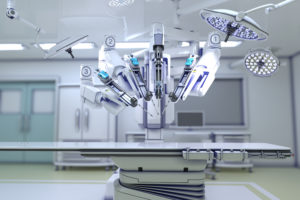Da Vinci surgery: Robot-assisted laparoscopic surgery.
Over the years, surgical techniques have changed as technology has improved. Traditionally, many urologic surgeries were performed as ‘open’ procedures – entering the body through a large incision. This form of surgery was invasive, and impacted how long it took the body to heal. In addition, exposing a large portion of the internal body, for long periods of time, put patients at a higher risk of infection.
A dramatic shift in surgical technique occurred with the introduction of laparoscopic surgery. By using this minimally invasive approach, surgeons perform surgery through several small incisions. Smaller openings help minimize blood loss, infection, and promote healing.
Today, laparoscopic surgery has evolved into robot-assisted laparoscopic surgery. This technology involves the use of a robotic surgical platform – da Vinci surgery – developed by Intuitive Surgical Systems. This system consists of a four-armed robot (one arm controls a high definition camera; the other three arms control instruments), and a console where the surgeon sits to control the robot.
The robotic arms function like human hands, and give the surgeon unparalleled dexterity, precision, and maneuverability. The surgeon has complete control at all times; the robot is never in control of the surgery.
Da Vinci surgery allows complex surgical dissection and reconstruction for:
- Prostate cancer surgery (robot-assisted laparoscopic prostatectomy).
- Kidney cancer surgery (robot-assisted radical nephrectomy and partial nephrectomy).
- Bladder cancer surgery (robot-assisted radical cystectomy).
- Reconstructive surgical procedures of the ureter such as ureteropelvic junction obstruction repair (robot-assisted laparoscopic pyeloplasty).
Along with these urologic procedures, da Vinci surgery is utilized by surgeons in many medical specialties.
Robotic surgery is quite complex and involves specialized training for the surgeon. During the procedure, the urologist depends on a dedicated surgical team: a bedside surgical assistant, a surgical nurse and an Anesthesiologist. It is important that this team work in unity to accomplish desired surgical outcomes.
Robotic surgery benefits patients through decreased blood loss, a shorter hospital stay, and quick recovery time.

